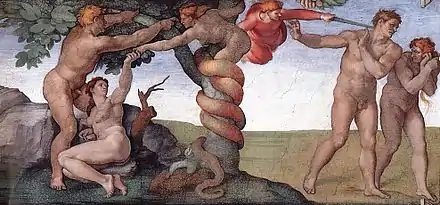
In the biblical story of Adam and Eve, coats of skin (Hebrew: כתנות עור, romanized: kāṯənōṯ ‘ōr, SG coat of skin) were the aprons provided to Adam and Eve by God when they fell from a state of innocent obedience under Him to a state of guilty disobedience.[1][2]
Genesis 3:21
As per the biblical interpretation of Genesis 3:21, God produced coats of skin for the first man and woman Adam and Eve and clothed them when they were found naked in the garden after eating the forbidden fruit.[3]
Material
The material of coats is not clear; instead, it is dubious. The Bible translates "coats" of skin and "garments" of skin as our mortal skin and animal' skin.[4]
Symbolic
If clothes were of animal skin, the question arises, who killed the animal and what was that? These ''garments'' of skin are resolved as a symbol of salvation.[5]
Wisdom
The first man and woman didn't even know how to dress properly. Their fig-leaf aprons served no purpose. In their "shame" the first couple always found it necessary to hide themselves from God (Gen.3.8).
And they heard the sound of the Lord God walking in the garden in the cool of the day, and the man and his wife hid themselves from the presence of the Lord God among the trees of the garden.
— Genesis 3:8[6]
God's creation of the "coats of skins" can thus be seen as a sign of his superior wisdom, his recognition of his people' true needs in light of their impending expulsion from the Garden.
And the LORD God made for Adam and his wife garments of skins and clothed them
— Genesis 3:21[7]
Gallery
 The Garden of Eden with the Fall of Man by Jan Brueghel the Elder and Pieter Paul Rubens, c. 1615, depicting both domestic and exotic wild animals such as tigers, parrots and ostriches co-existing in the garden
The Garden of Eden with the Fall of Man by Jan Brueghel the Elder and Pieter Paul Rubens, c. 1615, depicting both domestic and exotic wild animals such as tigers, parrots and ostriches co-existing in the garden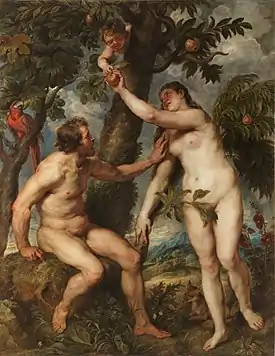 The Fall of Man by Peter Paul Rubens, 1628–29
The Fall of Man by Peter Paul Rubens, 1628–29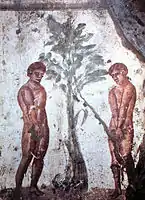 Early Christian depiction of Adam and Eve in the Catacombs of Marcellinus and Peter
Early Christian depiction of Adam and Eve in the Catacombs of Marcellinus and Peter Detail of a stained glass window (12th century) in Saint-Julien cathedral - Le Mans, France
Detail of a stained glass window (12th century) in Saint-Julien cathedral - Le Mans, France Depiction of the Fall in Kunsthalle Hamburg, by Master Bertram, 1375-1383
Depiction of the Fall in Kunsthalle Hamburg, by Master Bertram, 1375-1383 Adam and Eve, engraving by Albrecht Dürer, 1504 (National Gallery of Art)
Adam and Eve, engraving by Albrecht Dürer, 1504 (National Gallery of Art)_2.jpg.webp) Adam and Eve by Albrecht Dürer, 1507
Adam and Eve by Albrecht Dürer, 1507_-_Google_Art_Project.jpg.webp) Adam and Eve in paradise (The Fall), Eve gives Adam the forbidden fruit, by Lucas Cranach the Elder, 1533
Adam and Eve in paradise (The Fall), Eve gives Adam the forbidden fruit, by Lucas Cranach the Elder, 1533 Adam and Eve from a copy of the Falnama (Book of Omens) ascribed to Ja'far al-Sadiq, c. 1550, Safavid dynasty, Iran
Adam and Eve from a copy of the Falnama (Book of Omens) ascribed to Ja'far al-Sadiq, c. 1550, Safavid dynasty, Iran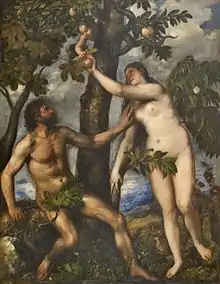 Adam and Eve by Titian, c. 1550
Adam and Eve by Titian, c. 1550 Adam and Eve by Maarten van Heemskerck, 1550
Adam and Eve by Maarten van Heemskerck, 1550 Adam and Eve Driven From Paradise by James Tissot, c. 1896-1902
Adam and Eve Driven From Paradise by James Tissot, c. 1896-1902 Adam and Eve depicted in a mural in Abreha wa Atsbeha Church, Ethiopia
Adam and Eve depicted in a mural in Abreha wa Atsbeha Church, Ethiopia 1896 illustration of Eve handing Adam the forbidden fruit
1896 illustration of Eve handing Adam the forbidden fruit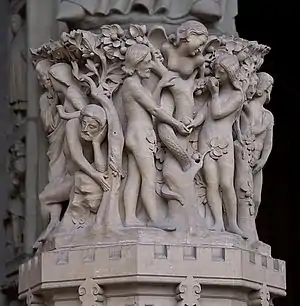 Adam, Eve, and the (female) serpent (often identified as Lilith) at the entrance to Notre Dame Cathedral in Paris
Adam, Eve, and the (female) serpent (often identified as Lilith) at the entrance to Notre Dame Cathedral in Paris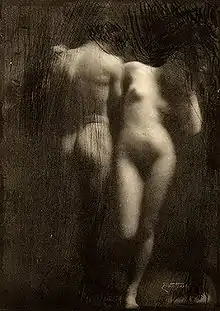 Adam and Eve by Frank Eugene, taken 1898, published in Camera Work no. 30, 1910
Adam and Eve by Frank Eugene, taken 1898, published in Camera Work no. 30, 1910 The Woman, the Man, and the Serpent by Byam Shaw, 1911
The Woman, the Man, and the Serpent by Byam Shaw, 1911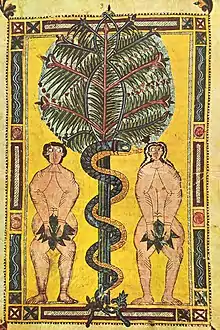 Adam and Eve in an illuminated manuscript (c. 950)
Adam and Eve in an illuminated manuscript (c. 950)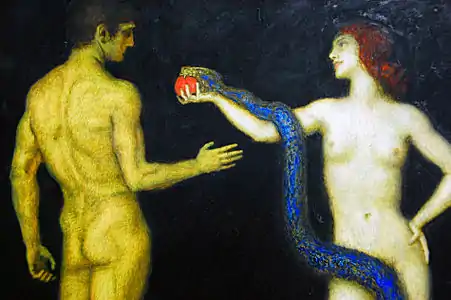 Adam and Eve by Franz Stuck, 1920
Adam and Eve by Franz Stuck, 1920 God Judging Adam by William Blake, 1795, Tate Collection
God Judging Adam by William Blake, 1795, Tate Collection
See also
References
- ↑ Easton, Matthew George. The Ultimate Bible Dictionary, Volume 1: A-F. Jazzybee Verlag. p. 183. ISBN 978-3-8496-9423-4.
- ↑ Easton, Matthew George (2012). The Ultimate Bible Dictionary (Annotated ed.). Jazzybee Verlag. ISBN 978-3-8496-2186-5.
- ↑ "Genesis 3 / Hebrew - English Bible / Mechon-Mamre". www.mechon-mamre.org. Retrieved 2021-07-23.
- ↑ "The Lord made garments of skin -- whose skin? • Eve Out of the Garden". Eve Out of the Garden. 2018-05-26. Retrieved 2021-07-23.
- ↑ Andreasen, Milian Lauritz (2006). The Sanctuary Service. Review and Herald Pub Assoc. pp. 11, 12. ISBN 978-0-8280-1989-7.
- ↑ endofthematter (2019-10-22). "Hiding from God (Genesis 3:8)". Endofthematter.com. Retrieved 2021-07-23.
- ↑ "Genesis 3". ESV Bible. Retrieved 2021-07-23.
